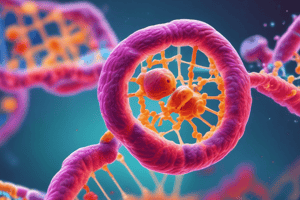Podcast
Questions and Answers
Histone variants can have an impact on gene transcription when located near the promoter.
Histone variants can have an impact on gene transcription when located near the promoter.
True (A)
Covalent histone modifications include only acetylation and phosphorylation.
Covalent histone modifications include only acetylation and phosphorylation.
False (B)
Histone acetylation causes the DNA to wrap more tightly around the histones.
Histone acetylation causes the DNA to wrap more tightly around the histones.
False (B)
Over 50 enzymes that modify histones have been identified in humans.
Over 50 enzymes that modify histones have been identified in humans.
DNA methylation generally promotes transcription when it occurs near promoters.
DNA methylation generally promotes transcription when it occurs near promoters.
Covalent histone modifications can alter the level of transcription by affecting nucleosome interactions.
Covalent histone modifications can alter the level of transcription by affecting nucleosome interactions.
Gene expression is the process by which information within a gene is used to produce a functional product.
Gene expression is the process by which information within a gene is used to produce a functional product.
Epigenetic regulation involves irreversible changes in gene expression.
Epigenetic regulation involves irreversible changes in gene expression.
Transcriptional regulation only ensures that transcription occurs but does not affect the extent of transcription.
Transcriptional regulation only ensures that transcription occurs but does not affect the extent of transcription.
Post-transcriptional regulation involves controlling gene expression at the RNA level.
Post-transcriptional regulation involves controlling gene expression at the RNA level.
The central dogma of molecular biology describes the flow of information from RNA to protein.
The central dogma of molecular biology describes the flow of information from RNA to protein.
Translational regulation involves controlling the rate at which transcription occurs.
Translational regulation involves controlling the rate at which transcription occurs.
Repressors and activators are examples of factors involved in translational regulation.
Repressors and activators are examples of factors involved in translational regulation.
Gene expression is completely independent of environmental factors.
Gene expression is completely independent of environmental factors.
Methylation near the promoter generally increases the level of transcription.
Methylation near the promoter generally increases the level of transcription.
Euchromatin is transcriptionally active due to its less condensed structure.
Euchromatin is transcriptionally active due to its less condensed structure.
Facultative heterochromatin remains in the same form across all cell types.
Facultative heterochromatin remains in the same form across all cell types.
HP1 (heterochromatin protein 1) contributes to the compaction of nucleosomes.
HP1 (heterochromatin protein 1) contributes to the compaction of nucleosomes.
Heterochromatin patterns are established only after embryonic development.
Heterochromatin patterns are established only after embryonic development.
Chromatin remodeling can involve the rearrangement of nucleosomes.
Chromatin remodeling can involve the rearrangement of nucleosomes.
Post-translational regulation involves controlling the activity of proteins.
Post-translational regulation involves controlling the activity of proteins.
Non-coding RNAs are responsible for encoding proteins.
Non-coding RNAs are responsible for encoding proteins.
Epigenetic regulation leads to irreversible changes in gene expression.
Epigenetic regulation leads to irreversible changes in gene expression.
DNA methylation usually promotes gene transcription.
DNA methylation usually promotes gene transcription.
Hemimethylated DNA refers to DNA that is partially methylated.
Hemimethylated DNA refers to DNA that is partially methylated.
DNA methyltransferase is responsible for the removal of methyl groups from DNA.
DNA methyltransferase is responsible for the removal of methyl groups from DNA.
Covalent modifications are an example of post-translational regulation.
Covalent modifications are an example of post-translational regulation.
Chromatin remodeling involves changes to the structure of proteins after translation.
Chromatin remodeling involves changes to the structure of proteins after translation.
Methylation near promoter sites may impact the process of transcription.
Methylation near promoter sites may impact the process of transcription.
Covalent histone modification does not affect gene expression.
Covalent histone modification does not affect gene expression.
Flashcards are hidden until you start studying
Study Notes
Histone Variants
- Histone variants can change the structure of chromatin
- There are five main types of histones: H1, H2A, H2B, H3, and H4
- Histone variants are modified histone genes that have accumulated mutations that alter the amino acid sequence
- Histone variants are found in specific regions of the genome, such as the promoter
Covalent Histone Modifications
- Over 50 enzymes identified in mammals can modify the amino-terminal tails of histones
- Common modifications include: acetylation (COCH3), methylation (CH3), and phosphorylation (phosphate groups)
- Covalent histone modification affects the level of transcription by influencing interactions within nucleosomes
- Acetylation loosens the DNA around histones, making it more accessible to transcription factors, thereby increasing transcription
Chromatin Remodeling
- Involves changing the structure of the chromosome by moving, removing, or rearranging nucleosomes
- Chromatin is divided into heterochromatin (tightly compacted, transcriptionally inactive) and euchromatin (less condensed, transcriptionally active)
- Facultative heterochromatin is able to switch between euchromatin and heterochromatin
- Heterochromatin can bind to the nuclear lamina
- Patterns in chromatin can be passed to daughter cells
- Heterochromatin patterns are established during embryonic development
- Constitutive heterochromatin – the same in all cell types
- Facultative heterochromatin – cell-specific
DNA Methylation
- Involves the covalent attachment of methyl groups (-CH3) to cytosine bases in DNA
- Methylation is carried out by DNA methyltransferases
- Methylation typically inhibits gene transcription, particularly near promoters
- DNA methylation is heritable
- Unmethylated regions of DNA can be methylated by de novo methylation
- Hemimethylated DNA can be fully methylated through maintenance methylation
Epigenetic Regulation
- Epigenetic changes are heritable, reversible, and happen without changes in the DNA sequence
- Play a role in development (change throughout an organism's life) and can be impacted by the environment
- Major types of epigenetic regulation include:
- DNA methylation
- Chromatin remodeling
- Covalent histone modification
- Localization of histone variants
Studying That Suits You
Use AI to generate personalized quizzes and flashcards to suit your learning preferences.




